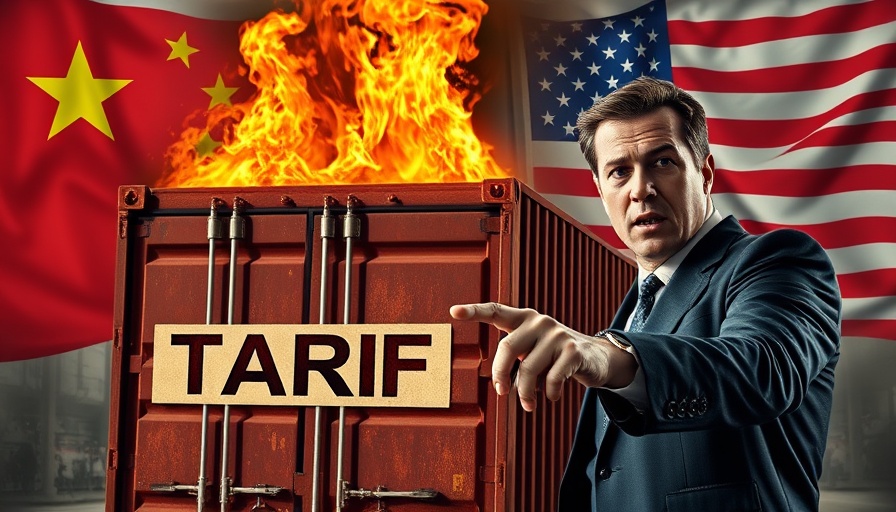
Understanding the Economic Landscape: What Lies Ahead?
The current economic climate, significantly influenced by former President Trump's tariffs, poses an alarming threat to the U.S. and global economies alike. Economic analysts are increasingly expressing concerns about a potential recession. However, the grim forecast for the economy goes beyond simple recession; stagnation coupled with inflation, known as stagflation, is becoming a pressing topic of discussion. To stay informed and unravel this complex issue, we must break down what stagflation is, its potential impacts, and how we might navigate these turbulent economic waters.
In 'Tariffs & Stagflation: Global Economic Crash Incoming!?' the discussion dives into the critical issue of stagflation, exploring key insights that sparked deeper analysis on our end.
What is Stagflation and Why It Matters?
Stagflation is characterized by a toxic blend of stagnant economic growth, high inflation, and soaring unemployment. These conditions typically do not occur together as economic principles suggest inflation should decrease with rising unemployment due to lower demand. However, this is not always the case. Historical perspectives remind us of its profound impact on the economy, as seen during the 1970s energy crisis, which enveloped the U.S. in a vicious cycle of economic despair. The term 'stagflation' emerged from the combined forces of high unemployment and inflation, presenting a unique challenge for policymakers who found it difficult to stabilize both inflation and job growth simultaneously.
Historical Context: Lessons from the 1970s
The stakes are high when we consider the bleak context of stagflation, primarily due to its rarity and the severe consequences it entails. A historical lens reveals that the 1970s stagflation resulted from external shocks like the oil embargo, which escalated costs while crippling production—an all too familiar scenario reminiscent of recent supply chain disruptions fueled by geopolitical tensions. Additionally, soaring inflation and employment risks hinder cost-effective measures to counteract these challenges. Confounding this era's lessons is the understanding that while we may now face similar conditions, the current economic framework and market dynamism may prompt different outcomes.
Impact of Tariffs on Global Trade and Domestic Markets
The direct influence of tariffs on trade and the national economy should not be understated. As U.S.-China relations deteriorate amidst increasing tariffs, both nations now see the repercussions echoing throughout global markets. These tariffs have transformed from temporary measures to permanent fixtures, drastically reshaping production strategies. With tariffs on critical production materials increasing costs for manufacturers, companies may find themselves unable to remain competitive, risking further unemployment and economic stagnation.
What Can We Expect Moving Forward?
The current state of tariff-induced conditions signals a precarious road ahead. It raises questions about the sustainability of growth within our financial systems. While the ramifications are immediate, the long-term impact of current policies is that the higher input costs will ultimately lead to diminished consumer spending, further disincentivizing corporate investment. Analysts suggest that unless critical tariffs are reassessed or eliminated, the U.S. could face a stagnation that not only limits growth but also leads us into potential stagflation. This could necessitate a systemic strategy from policymakers to restore confidence in growth trajectories while managing inflation.
Dealing with Stagnation: Navigating Policy Responses
In these uncertain times, understanding how policymakers might respond is essential for business and investors alike. Traditionally, the Federal Reserve can leverage interest rates to stabilize inflation; however, this may prove counterproductive in any stagflation scenario where unemployment is already high. Thus, navigating this unique economic paradox demands swift and informed policy actions, potentially leading to either drastic interest rate hikes or expanded fiscal policies to stimulate job growth.
Your Role in This Financial Landscape
For investors and market participants, grasping the variables affecting the current economic paradigm is crucial. With the potential for both a recession and stagflation looming, risk management becomes a thematic focus. Diversification strategies, like exploring cryptocurrency as an alternative asset class, may be beneficial in mitigating financial turmoil. As macroeconomic trends shape our market landscape, following credible sources of information, such as Coin Bureau educational materials, could provide valuable insights into asset protection amidst evolving challenges.
Ultimately, understanding stagflation and its implications empowers both individuals and businesses to make informed decisions. Utilizing tools and techniques from crypto trading strategies to effective risk management can bolster financial resilience as we navigate this turbulent economic environment. By actively educating ourselves and adapting to changes, we can explore viable pathways through this potential crisis.
Call to Action
Join the community of forward-thinking investors and enthusiasts at Coin Bureau. Stay updated with comprehensive articles, educational webinars, and market updates to enhance your understanding of the evolving financial landscape. Don’t miss out on key insights—sign up for the Coin Bureau newsletter today and explore how you can thrive even amidst economic uncertainty.
 Add Row
Add Row  Add
Add 




 Add Row
Add Row  Add
Add
Write A Comment